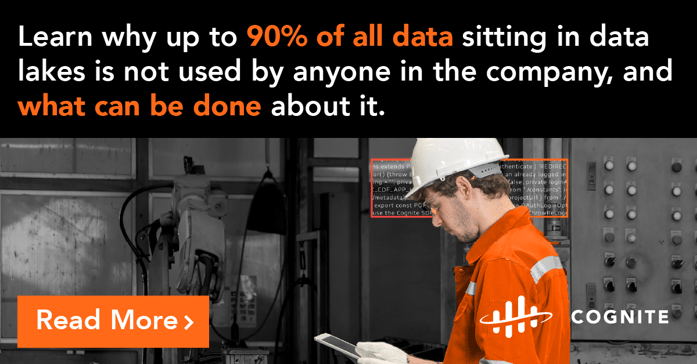
Modern manufacturing is about realising possibilities through technology. Data lakes have become commonplace, but their enormous potential remains untapped across manufacturing companies. As much as 90% of all data sitting in data lakes is not used by anyone in the company. And it’s not because the industry isn’t collecting enough data. It’s because it needs context.
Unlock the value of your industrial data
Data lakes are central to the digitalisation of manufacturing. But there are usually only a few people within the organisation who understand how to effectively navigate them, as data lakes only store raw, untransformed data. That’s like having a set of coordinates but no map—useless to most people.
To bridge the gap between data and people, manufacturers need the right infrastructure to store, refine, and make the relevant data available to anyone who needs it to create business value.
Nordic manufacturer Aarbakke has put this theory to the test. According to their CTO Rolf Thu, “With the powerful data we have, we can do many things to improve our processes and reduce our carbon footprint. We can track and trace, analyse, and see where the emissions are coming from—and then take action to reduce it.”
He added, “One of the biggest benefits is how rapidly we can move from idea to solution. We are also able to work with enormous amounts of data using a very lean team. And we can do amazing stuff with it because the tools and the data preparation are so good. We’re developing things quickly and cheaply, which is positive for our ROI.”
How to make sense of your data
Aarbakke was able to break down the walls between the separate systems that tracked machine operation data and work orders, helping the company analyse and optimise cutting tool usage. This solution is helping the manufacturer reduce tool assemblies by 60% and increase cutting tool efficiency by 10%. Aarbakke were also able to monitor more than 22,000 unique cutting tools.
In another example, the manufacturer created a dashboard of CNC machine alarms, helping their engineers reduce the number of breakdowns and extend the lifetime of the machines, resulting in 20-30% reduced service costs and reduced down time and unplanned stops.
Just as this example shows, the first and most essential step to make your data useful is by contextualising it. Contextualisation makes your data accessible so that everyone in your organisation can draw insights into your data and operations. Assets in your facility may have process variables, work orders, documents, and inspection data across several sources all residing in your data lake.
Contextualisation establishes a meaningful relationship between the data sources and types, empowering everyone in the organisation with real-time information, democratising knowledge previously only available to experts, and rapidly developing and scaling new and existing applications.
Data in context enables you to see your pain points guiding you to almost unlimited possibilities to improve. It gives you the insight to see which tools have the greatest potential for optimisation and how you can increase utilization of your assets.
Digital decision-making based on trusted data and real-time insights
Today, manufacturers rely on data and analytics to make decisions. For data to be operationally used at scale, it needs to be trusted and consistent.
If you and your colleagues don’t trust your data, it’s useless. In order to build trust in your data, it is vital to ensure that the time series data used to generate insights is in a healthy state. By integrating data from a range of dispersed sources into one place, you can manage and control your data. Access to detailed time series data allows you to easily verify the quality of the data, and also modify requirements based on specific use cases. Without verifying the quality of the data, your teams can end up reacting to inaccurate data. With the right solutions, you can automate data cleaning, save significant amounts of time, and most importantly get accurate data for decision-making.
On their own, data lakes provide no business value. To provide value, data has to be contextualised, accessible, and trusted. Once you realise the value of your data, you are laying the foundation that will make your operations more efficient, smarter, and even achieve greater sustainability.